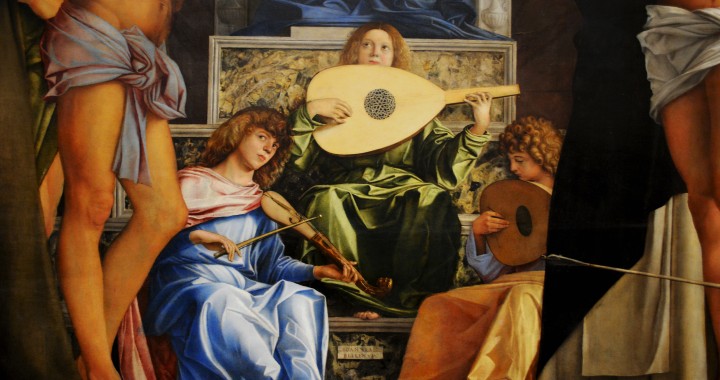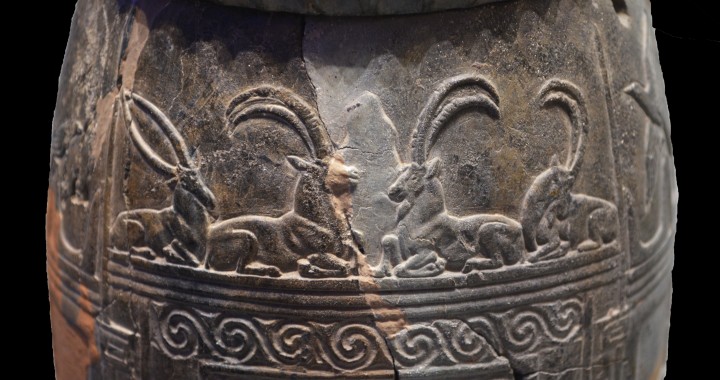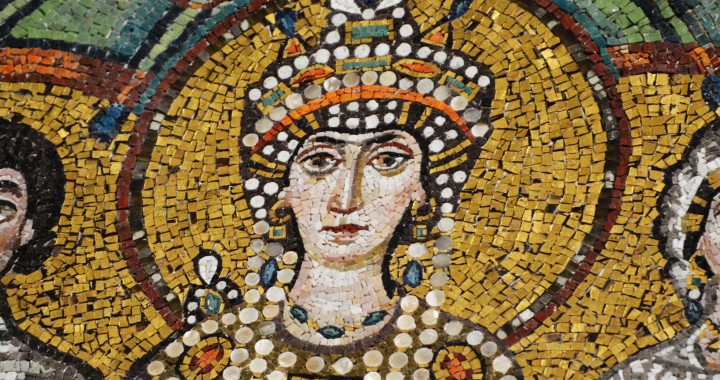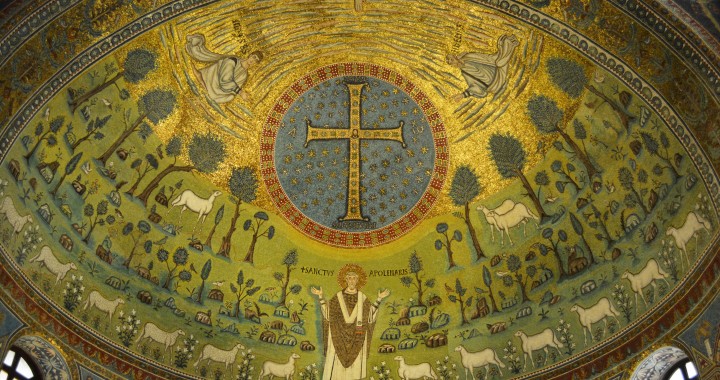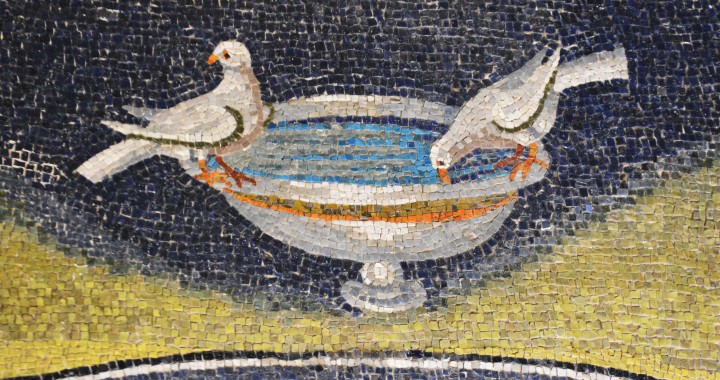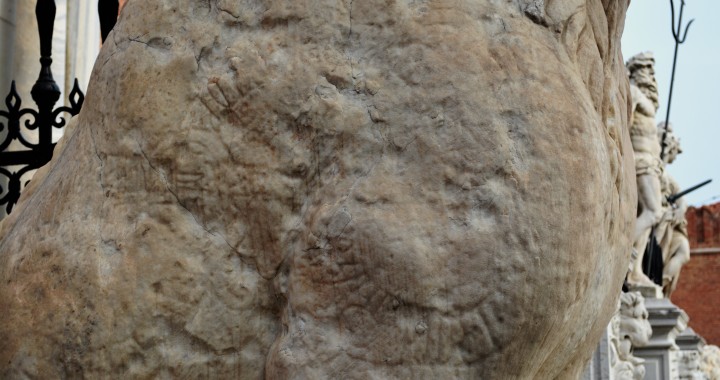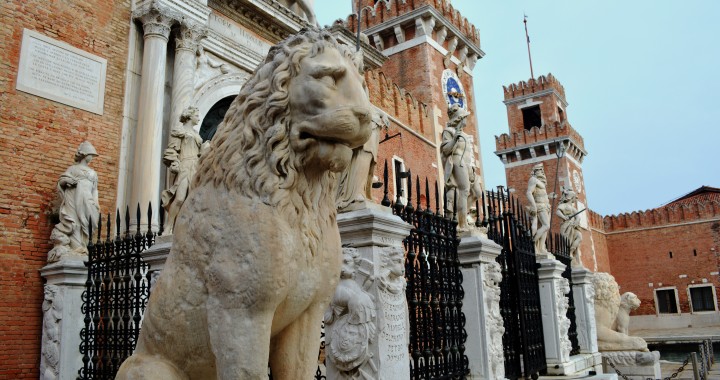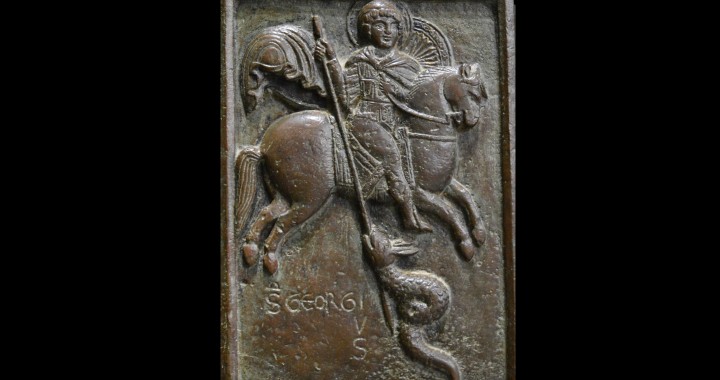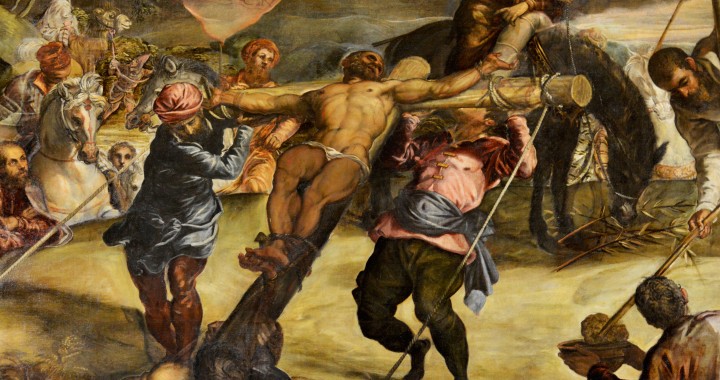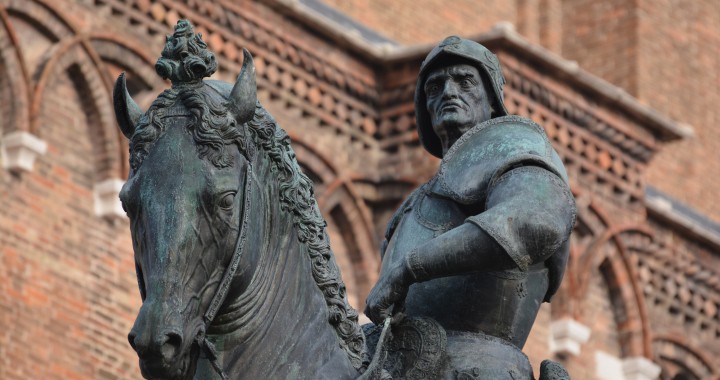My Monthly Archives: November 2015
Bellini’s Drapery
I was at the Accademia Museum in Venice again today and took a picture of part of Giovanni Bellini’s San Giobbe altarpiece (1487), of the wingless angels in the lower middle of the painting who make up a striking musical trio. This time I was impressed by the draperies of their clothing; the sheen and crisp rhythm of the folds. When I was first studying art history you weren’t supposed to be impressed with such things; they distracted one from the social function of the work of art. ‘Formalism’ was a dirty word. No good Marxist worth their salt would think of noticing such a bourgeois detail. However, no longer being an academic, and since Marxism is now passé, I can now once again freely revel in it. I love the glance of the angel on the left, the one with the magnificent blue robes and impressive hair. What he’s looking at is hard to tell, the figure of Job, perhaps, who wears only a loin-cloth, though it seems to be of very costly iridescent shot silk. I guess if you’re only going to have one outfit, it should be a good one. Tarzan eat your heart out.
Revisiting: Heraklion, Crete
The recently reopened Archaeological Museum in Heraklion, Crete, is fantastic. I was lucky enough to visit this past September, just two short months ago. Many more artifacts are on display, and the displays themselves are wonderful. You get to see so many incredible things produced by the Minoan civilization. One of them is this vase with a band of decoration showing ibexes. The ones in the middle are posing heroically and symmetrically for their snapshots, proper fellows, while the one on the right has been distracted and is biting at an itchy spot– a bit of naturalistic, behavioral detail. The Minoans must have loved nature as plants and animals figure heavily in their representational art, still vibrant and compelling 3500 years later.
Revisiting: Agrigento
On slow days like today I find myself thinking back to things I saw these past months that I didn’t get to share on the blog. I was browsing through some pictures from the last few months and came across this one that I took in the Agrigento Archaeological Museum (Sicily). It’s a detail of a Greek vase from the 5th century BCE that shows Perseus, who has already slain the marine serpent who is about to devour the maiden Andromeda. He pauses for a moment, puts a foot up onto a rock, places his elbow on his knee and briefly regards the beautiful woman chained to a rock, as if mesmerized by her loveliness. The profile is so economically rendered, as are his robes. His hair falls in black ringlets. It’s strange to see the calmness of it, the moment of stillness and contemplation. Perseus, a real hero, makes it all seem easy; all in a day’s work. The orange bits are where the white paint of the vase has been chipped, revealing the terra cotta underneath.
Going to the Dogs
Look at the image in the previous post (see below). This picture is just below it, and you can see the overlap. But what interested me here in this second, lower picture of the group of Borso and his courtiers was the way they all used their hands, many of them gloved, to show their elegant and measured gestures; restraint and grace being the hallmarks of the movements of the nobility. The dogs are great too. I love the two that look like greyhounds, with their slim muzzles and wonderful ears. They peer down at a mongrel pooch who is a bit sorry looking (you can just see the top of his head), imitating exactly what is going on in the human world just above as Borso gives a coin to his servant, who may be the keeper of his hunting dogs. So even here the great hierarchy of being is reflected: the animal world reflects the human world just above that, and above the humans the stars and heavenly bodies, and above those the realms of the Olympian gods. There was only one other person there today, a beautiful Russian woman about 30 years of age. She was taking notes very seriously, as I did 25 years before at about her age. I talked to her a bit; she’d come from Moscow, where she studies art history, to see the frescoes. That’s some field trip. She just had a little point-and-shoot camera so I offered to send her some of my pictures if she needed them. I was trying to be chivalrous: a courtly ideal, though in the frescos of April and May, of spring, love is the theme. I dreamt of cold Russian nights… in bed with a fireplace flickering. As I left I tried to make a joke with the guard, who was doing crosswords, saying that it was ironic that she had such a boring job in a palazzo named Schifanoia. I’m not sure if she got it or not; she smiled weakly and just said, “arrivederci”.
Away Boredom!
Today I took the train from Padua to Ferrara, which took about an hour. I wanted to go back to a place I’d visited years before, the Palazzo Schifnaoia, which means “[Go] Away Boredom!” It was a place for the Este dukes to relax and have a good time, just a bit outside the center of the town with all its responsibilities of rule and bureaucracy. I’d done a seminar paper on it once, so felt I had a sort of responsibility to see it again. Around 1470 Duke Borso d’Este commissioned a huge room in the palace–a grand reception room about the size of a tennis court–to be painted with large wall frescoes showing the months of the years, their astrological symbols, the Olympian gods associated with them, and the courtly activities of the duke in the lowest, earthly level. Thus the everyday was linked to the months, seasons, and movements of the heavens and the gods. Borso d’Este has been used as an example of a sort of retrograde type of patron from around 1470; instead of paying his painters for their skill, as was quickly becoming the enlightened norm, he negotiated a price per square foot. There was a team of painters, including Cosimo Tura, Francesco del Cossa, and Ercole de’ Roberti. As always, I’m looking at the details realized by the painters. In this one we see Borso d’Este smiling and hanging out with his courtiers. He’s pleased with one of his underlings (see above post) probably giving him a gold coin, but the gold leaf once used to show it is long gone. All around Borso we see his courtiers: scholars, young men in fine clothes; they exemplify the courtly concept of magnificenza or ‘magnificence’. So here is a snippet of the splendor of the Este court in Ferrara; a snapshot from 545 years ago.
Theodora’s Procession
Here’s the whole mosaic, of which the previous posting is a detail. There’s some distortion, because I had to photograph it from a fairly sharp angle, but you get the idea of the empress’s imperial procession. There’s a pendant to it on the other side of the apse, another mosaic that shows the Emperor Justinian (not Justin Trudeau you Canadians; at least not yet) in a similar votive procession.
Empress Theodora at San Vitale, Ravenna
I can’t tell you how difficult it was to get this picture. I had to take 25 out-of-focus ones before I finally managed to steady myself enough in the dark interior, from a distance of about 30 feet with the 300 mm lens. This is a detail of a famous mosaic of the Byzantine Empress Theodora in a procession of court ladies and attendants donating a golden bejeweled, liturgical bowl to a church. She is in splendid imperial purple robes (I’ll put an image of the whole piece above) and decorated with sumptuous jewelry. Her court ladies are lovely and also in their Sunday best. It’s just one of Ravenna’s wonders, and for a day ticket of only 9.50 euro, you can visit all the churches, many of them UNESCO World Heritage sites, in the city.
Sant’ Apollinaire, Ravenna
The semi-dome of the church of Sant’ Apollinaire in Classe, just outside the modern city of Ravenna, is a wonder and could be my favorite single mosaic work (use your browser’s ‘back’ button to return to this site). In terms of size it’s big, rivaling some of the apse mosaics in the early Christian churches of Rome. But the colour is the real attraction: a lovely green creating a verdant landscape of paradise, which Saint Apollinaire, in the center, seems to welcome you to with open arms. The springtime landscape is filled with sheep (i.e. Christians) who line up to enter. All about are plants and trees, and birds can be found scattered everywhere. Above, a great cross floats in a blue heaven with golden stars. At the very apex the hand of god comes out of a cloud to bless Apollinaire. The whole scene glows with life and freshness, something I’ve never seen in any other mosaic.
Ravenna and the Glories of Byzantium
It seems strange that if you want to see the most impressive examples of Byzantine mosaics anywhere they are not to be found in Turkey or in Greece, but in Ravenna, Italy. Nowadays a sleepy minor port town, 1500 years ago it was the capital of the Western Byzantine empire and was patronized by emperors and empresses (see post above). One reason they survive here and not elsewhere in the lands that we most associate with Byzantium is that the Byzantines themselves destroyed much of their own figural art (paintings, mosaics, statues) in the periods of iconoclasm in the 9th and 10th centuries. So pre-iconoclastic period Byzantine art is rare, but by the iconoclastic period Ravenna was no longer in the sphere of the capital, and thus its works survived. Mosaics are my favorite mural art form, and I’ve seen some of the best in my travels. Ravenna is still a very special place and I’ll post a few images today. This little detail is from the Mausoleum of Galla Placidia from the 5th century. It shows doves drinking from a bowl, a motif that is seem elsewhere in the building. It alludes to paradise and the clear waters of the rivers of paradise, from which one will be able to drink freely. So the idea of salvation fits with the structure’s funerary context and the hope for a life in heaven thereafter.
A Detail for Previous Post
The runes are difficult to see in the previous picture, so here’s one that shows a close-up. I’ve increased the contrast in Photoshop to make the inscriptions, or what’s left of them after 1000 years, a bit more legible.
If this Kitty Could Talk
Yesterday I was in Venice and went to the Arsenale Gate, the monumental gateway to Venice’s medieval and renaissance-era shipyards and armaments factory area. The gateway was constructed in the late 15th century (1460), but substantially enlarged after 1571 in celebration of the naval victory at the Battle of Lepanto, which checked Ottoman advancement into the Adriatic. Part of the ancillary decorations are a series of lions stolen from various places throughout Venice’s colonial empire. See the one peeking his head out in the distance on the right? He’s from the island of Delos, in the Aegean, and he’s ancient Greek in origin, probably about 2500 years old. Several of his former mates are still standing there on Delos. The big fellow in the foreground left is the guy I want to talk about. He’s known as the ‘Piraeus Lion’. He, too, is an ancient Greek lion, from the 4th century BC. So around 2400 years old. He came from the port of Athens, Greece, which is how he got his name (Piraeus is the port of Athens). Where he originally came from is anybody’s guess, the Romans had put him in place in Piraeus in the first or second century CE. Italian voyagers called Piraeus ‘Porta Leone’ because of this lion. At some point, he was part of a fountain and spewed water from his mouth (the tubing still exists in his body). He was taken away by the Venetian commander Francesco Morosini in 1687. Morosini had been in Athens trying to take the city from the Ottoman Turks. It was one of his rockets that landed in the gunpowder magazine of the acropolis, which happened to be in the Parthenon, thus blowing out the entire south side of columns. So when you go there and see that big space with no columns you can think of dear Francesco. Morosini took, as part of the loot, this lion, and placed it at the Arsenale Gate as a monument to his victory. If that isn’t interesting enough, do you see that curving line on the lion’s ‘shoulder’? There are other curving lines and text is visible. They’re runic inscriptions carved by Viking Varangian soldiers who served the Byzantine emperors. They carved graffiti into the lion some time in the 11th century while the lion was in Piraeus. The Vikings, when they took the port, lost a kinsman named Horsi, and carved the runes in his honour. Part of the inscription reads: “They cut him down in the midst of his forces. But in the harbor the men cut runes by the sea in memory of Horsi, a good warrior. The Swedes set this on the lion. He went his way with good counsel, gold he won in his travels.The warriors cut runes, hewed them in an ornamental scroll. Áskell [and others] and ÞorlæifR had them well cut, they who lived in Roslagen. [N. N.] son of [N. N.] cut these runes. UlfR and [N. N.] colored them in memory of Horsi.” Apparently they were painted when originally done. Like I say, if this lion could talk. It seemed banal to reduce this magnificent feline to the symbol of the evangelist St Mark; he was a creature who stood proud over ancient centuries long before St Mark ever walked the earth.

